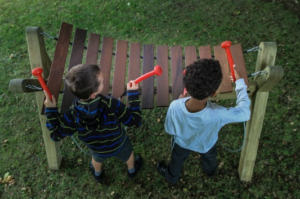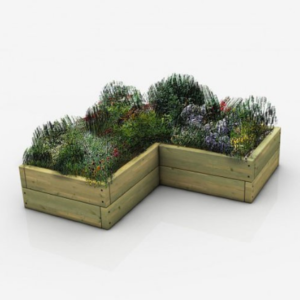-1000x1000.png)
Sensory gardens have a vast range of benefits and are a perfect way to improve the sensory development of autism sufferers.
Autism is a developmental disability that impairs social interaction, communication, and behaviour. Sufferers find it hard to understand the emotions of others, and often have delayed language development. It is common for individuals with autism to suffer from a variety of cognitive, learning, emotional, and behaviour problems. There is no cure for autism, but speech and language therapy, occupational therapy, educational support, sensory aids and a number of autism interventions are available to help sufferers and improve their way of life.
A sensory garden stimulates all senses: sight, touch, taste, and sound, all through the use of different plants and materials. These gardens allow autism sufferers to explore their senses in a safe and stimulating environment. Early intervention is important for autistic children, and a sensory garden allows children to explore their senses without feeling overwhelmed by them.
When designing a sensory garden, it is good to be creative with the colours incorporated into the garden, for visual stimulation. Colour can come from plants, stones, gravel, and even bricks. The balance of this colour is extremely important; take care that you don’t introduce too many bright colours into one space.
Depending on the size of your sensory garden, you may want to include signs. Half of the autism population are non-verbal, and so communicating the intention of certain areas of the garden can be beneficial to these individuals.
In terms of sound, you can introduce peace and tranquillity whilst still stimulating the senses. You might decide to include water features in your sensory garden, or grasses that make interesting sounds. Pampas grass and Pearl grass are good for this. Calming sounds can also be produced by the wind blowing through leaves and stems, so plants like bamboos and large-leafed plants work extremely well.

Alternatively, you don’t have to focus on purely natural sounds; you could include some gentle instruments in the garden, such as the Cadenza, which can be fun for children to play with. Otherwise, wind chimes or a Sonora are lovely features to add to the garden.
All plants and materials will release different scents in your sensory garden. Good plants for this include honeysuckle, lavender, and mint. When planning the perfect scents for your sensory garden, choose smells that will complement each other; try and pair more subtle scents with a few stronger scents, to keep it interesting to the senses.
Taste may be a less obvious sense to appeal to with your sensory garden, but you can include some edible flowers in your garden. It might be best to keep all of the edible plants in the same area, so as not to confuse anyone on what can and cannot be eaten. You could also include some more obvious edible plants, such as fruit trees and bushes, or tomatoes and strawberries. A top tip from us would be a raspberry bush, easy to grow and a popular tasty fruit!
Touch is an important sense to appeal to in your sensory garden. You can experiment with a variety of different textures. Lamb’s ear plants are perfect for this; as you would expect from the name, they feel woolly and soft. Jerusalem sage

is another good option, which has soft leaves and stems, as well as nice colourful flowers. Then bring in some alternative textures, such as Houseleek, which has rigid leaves. Or African Sundew, which is sticky to touch.
As well as the natural aspects of your garden, carefully choose sensory garden products that can bring additional visual, noise, and touch stimulation. When designing the layout of your sensory garden, try and include some sensory pathways that all link up. These can be stepping stones, pebbles, bricks, or even tile mosaics. You can then plan some keyhole gardens, which produce an intimate space surrounded by the lovely sensory plants that you have chosen.
Studies have suggested that contact with nature can reduce symptoms of Autism Spectrum Disorder. Many children with autism also have a form of Sensory Integration Dysfunction (SID), which brings a hyper-sensitivity to all things sensory, so a carefully planned sensory garden provides a calming space for children to play outdoors. Providing distracting activities, such as sensory garden toys or gardening tasks, is a good way to help autistic children to overcome the hyper-sensitivity to their surroundings.
Generally being in nature is good for the health and well-being of an individual, but having a space designed specifically for an autism sufferer allows them to explore a space and find an area which makes them feel good. Giving individuals a choice of activities to participate in, or areas to explore, gives them a sense of control and feeling of empowerment and self-confidence.
At Experia, we have extensive knowledge in creating the perfect sensory garden for autism sufferers. If you need any advice or want to find out more, please do not hesitate to contact us.